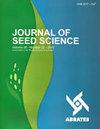Protective action of priming agents on Urochloa brizantha seeds under water restriction and salinity conditions
IF 1.2
4区 农林科学
Q3 AGRONOMY
引用次数: 7
Abstract
Abstract: Analyses of germination of seeds under artificial stress conditions are tools for a better understanding of the survival and adaptation capacity of species under natural stress conditions. Therefore, the aim of this study was to evaluate the effect of priming on seed germination, on breaking of dormancy, and on the length of Urochloa brizantha seedlings under water restriction and salt stress conditions. A completely randomized experimental design was used with four replications in a 3 × 6 factorial arrangement consisting of 3 germination conditions (water, water restriction with PEG, and salinity with NaCl) and 6 treatments [five priming solutions (distilled water, potassium nitrate, spermidine, gibberellin, and sodium nitroprusside) and a control (unprimed seeds)]. The following determinations were made: seed moisture content after priming (before drying) and after drying the seeds, germination test at seven and twenty-one days after sowing, germination speed index, viability by the tetrazolium test of the seeds remaining from the germination test, and seedling length. Priming is effective in minimizing the negative effects of water restriction and salinity. Use of sodium nitroprusside as a priming solution results in a lower percentage of dormant seeds and greater germination, vigor, and plant development.限制水分和盐度条件下引发剂对乌罗奇洛阿种子的保护作用
摘要:对人工胁迫条件下种子发芽的分析是更好地了解物种在自然胁迫条件下的生存和适应能力的工具。因此,本研究的目的是评估在水分限制和盐胁迫条件下,引发对乌罗虫种子发芽、打破休眠和幼苗长度的影响。采用完全随机的实验设计,在3×6因子安排中进行四次重复,包括3个发芽条件(水、PEG限制水分和NaCl盐度)和6个处理[五种引发溶液(蒸馏水、硝酸钾、亚精胺、赤霉素和硝普钠)和一个对照(未引发种子)]。进行以下测定:引发后(干燥前)和种子干燥后的种子水分含量、播种后第7天和第21天的发芽试验、发芽速度指数、发芽试验剩余种子的四氮唑活力试验以及幼苗长度。注水可以有效地将水限制和盐度的负面影响降至最低。使用硝普钠作为引发溶液可以降低休眠种子的百分比,提高发芽率、活力和植物发育。
本文章由计算机程序翻译,如有差异,请以英文原文为准。
求助全文
约1分钟内获得全文
求助全文
来源期刊

Journal of Seed Science
Agricultural and Biological Sciences-Agronomy and Crop Science
CiteScore
2.00
自引率
30.00%
发文量
28
审稿时长
12 weeks
期刊介绍:
From 2017 the Journal of Seed Science (JSS) will circulate online version only.
Original scientific studies and communications, not yet published or submitted to another journal for publication and written in Portuguese or English, will be accepted for publication. For manuscripts submitted in English, the authors should provide an adequated version.
The SCIENTIFIC COMMUNICATION is a category of scientific manuscript which describes a technique, an equipment, new species or observations and surveys of limited results. It has the same scientific rigor as the “Scientific Articles” and the same value as a publication. The classification of a manuscript as a SCIENTIFIC COMMUNICATION is based on its content and scientific merit but it can be a preliminary study, simple and not definitive on a certain subject, with publication justified by its uniqueness and contribution to the area.
The Editorial Board of the JSS may invite leading authors of recognized reputation to compose specific Review Articles covering topics of their specialization that will convey to the scientific community the state-of-the-art knowledge related to the specific theme.
 求助内容:
求助内容: 应助结果提醒方式:
应助结果提醒方式:


